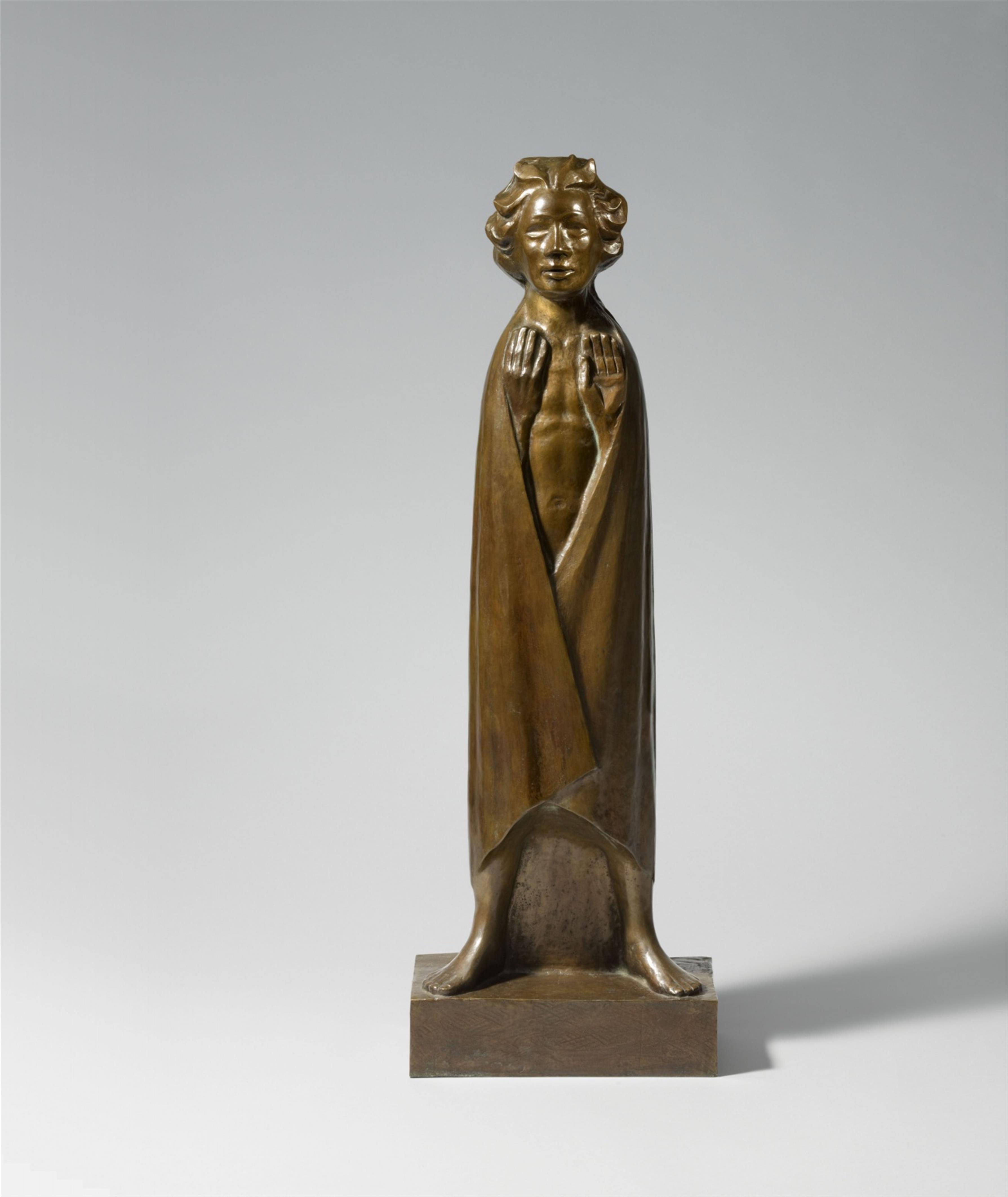Ernst Barlach
Die Flamme
1934
Bronze 113.2 x 38.6 x 18.8 cm Signed 'E.Barlach' and with the cast number to the upper right of the plinth, foundry stamp "H. NOACK BERLIN" to the lower right on the side. Cast 2/12 from the only posthumous edition of 1979, no lifetime casts exist. - With golden brown patina.
Ernst Barlach left behind a large part of his oeuvre in the form of fragile clay and plaster working models. Although Barlach became famous primarily as a sculptor in wood, most of his works were created not in wood but in these malleable, though relatively impermanent materials. “Die Flamme” was initially also carried out in the form of a free-standing plaster figure (Laur 555), on the basis of which the artist carved the version in oak (Laur 557). Barlach's more intensive occupation with the realisation of these working models in bronze began in the 1930s, when Alfred Flechtheim initiated bronze editions of selected works. Although the protracted work with wood was his preferred medium in some works, Barlach often saw the bronze cast as an appropriate form of permanently realising the much more spontaneously produced models in clay or plaster. “It was above all these pieces that call for bronze, in which the complete freshness of the momentary feeling remains preserved; here, it alone is able to remain faithful to and preserve the experience of these minutes” (cited in: Laur, p. 44). For this reason the trustees of the estate decided to posthumously cast several working models in small editions, and these included “Die Flamme”.
Barlach first carried out the motif of the “flame” in several charcoal drawings of 1927 (cf. Schult Zeichnungen 1889, 1890, 1892). Formally the motif is to be seen in connection with the figures of the “Fries der Lauschenden” and the “Gemeinschaft der Heiligen”, whose slender, statuesque forms reveal echoes of the sculptures of Romanic portals.
“The equally offensive and defensive impression made by the pose calls to mind the demeanour of a messenger or guardian. In the alienness of his outward form, the youth resembles an ethereal being from an unearthly sphere; in terms of its aura, however, his appearance also has something worldly about it. In their sign-like quality, the attitude of the hands resembles the highly expressive gestures of medieval sculptures. [...] the flame [can be] interpreted as the profession of a spiritual attitude characterised through a steadfastness in the search for truth. The gesture of the figure points to the fact that there is a human 'interior' and 'exterior', which call for a balancing: the demands that the outside world places on a human being require evaluation against one's own, inner standard. Conversely, the claim to truth of the individual's feeling and thinking has to prove itself in the credibility of practical activities.” (Caspers, op. cit., p. 106)
Catalogue Raisonné
Laur 556; cf. Schult 443 & 444
Literature
Anita Beloubek-Hammer, Ernst Barlach. Plastische Meisterwerke, Leipzig 1996, p. 136f.; Eva Caspers, Ernst Barlach Haus Hamburg, Munich et. al. 2000, p. 106f.
Exhibitions
Frankfurt 1981 (Frankfurter Kunstkabinett Hanna Bekker vom Rath), Ernst Barlach. 51 Bronzen, illus. p. 48; Hamburg 1983 (Bank für Gemeinwirtschaft und Ernst Barlach Gesellschaft), Barlach. Unbekannte Bronzen, illus. p. 26; Hamburg 2003 (Ernst Barlach Gesellschaft, Hauptkirche St. Katharinen), Ernst Barlach. Mystiker der Moderne, p. 268; Istanbul/Ankara & 2006/07 (Goethe-Institut), Wanderausstellung Ernst Barlach. Bildhauer der Moderne, illus. p. 168

